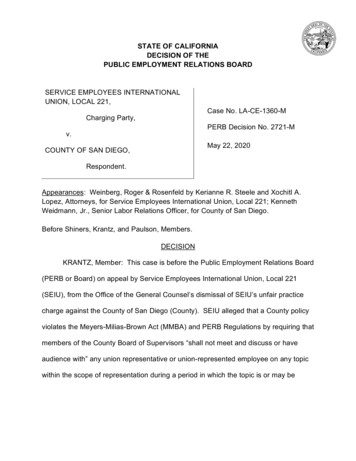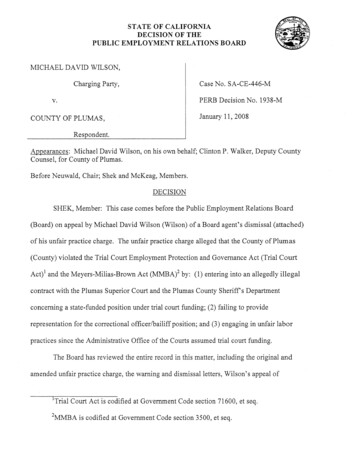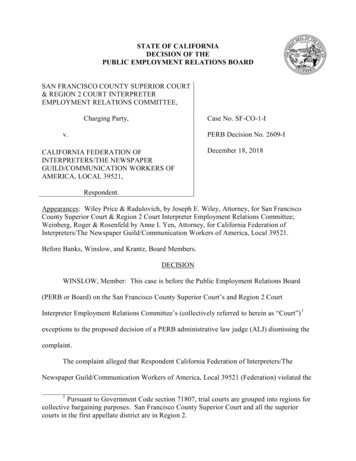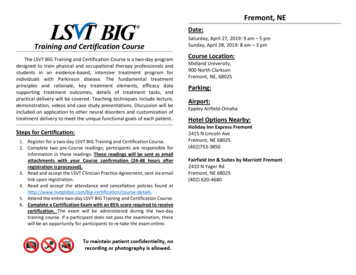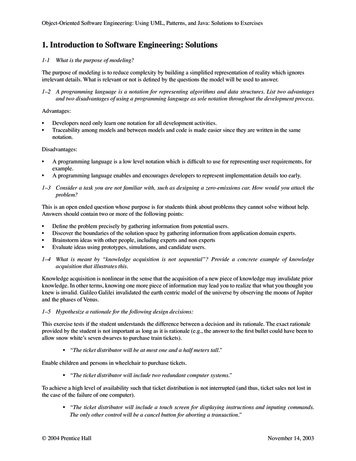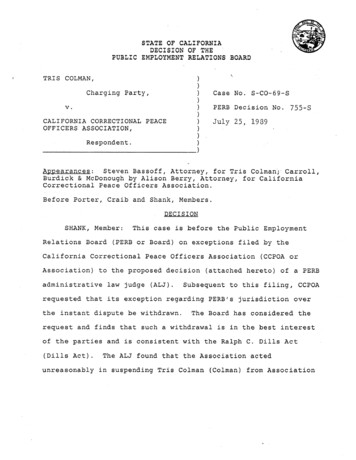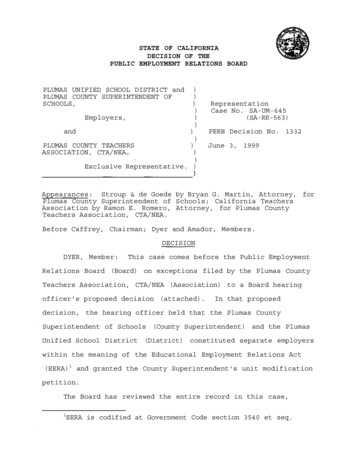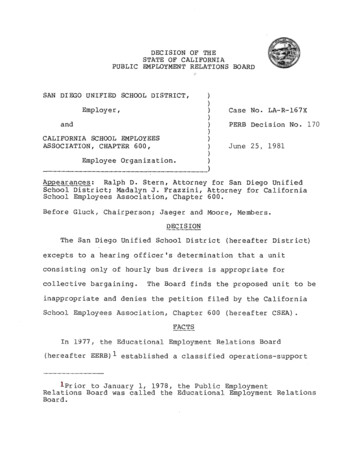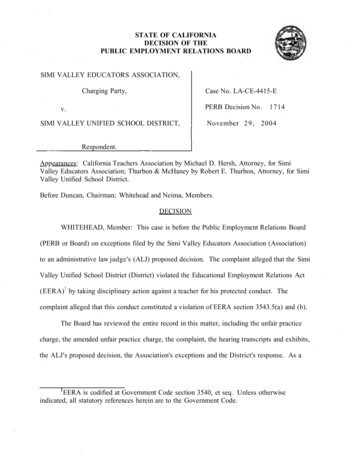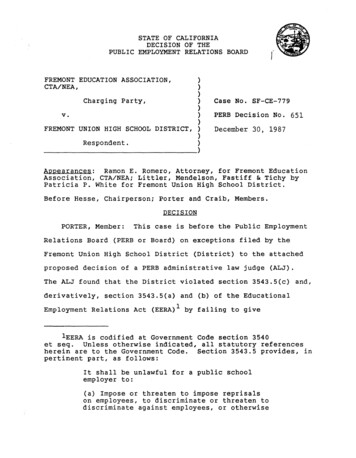
Transcription
STATE OF CALIFORNIADECISION OF THEPUBLIC EMPLOYMENT RELATIONS BOARDFREMONT EDUCATION ASSOCIATION,CTA/NEA,)))Charging Party,))v.))FREMONT UNION HIGH SCHOOL DISTRICT, ))Respondent.)Case No. SF-CE-779PERB Decision No. 651December 30, 1987 - Appearances: Ramon E. Romero, Attorney, for Fremont EducationAssociation, CTA/NEA; Littler, Mendelson, Fastiff & Tichy byPatricia P. White for Fremont Union High School District.Before Hesse, Chairperson; Porter and Craib, Members.DECISIONPORTER, Member:This case is before the Public EmploymentRelations Board {PERB or Board) on exceptions filed by theFremont Union High School District (District) to the attachedproposed decision of a PERB administrative law judge (ALJ).The ALJ found that the District violated section 3543.S(c) and,derivatively, section 3543.S(a) and (b) of the EducationalEmployment Relations Act (EERA) 1 by failing to givelEERA is codified at Government Code section 3540et seq. Unless otherwise indicated, all statutory referencesherein are to the Government Code. Section 3543.5 provides, inpertinent part, as follows:It shall be unlawful for a public schoolemployer to:(a) Impose or threaten to impose reprisalson employees, to discriminate or threaten todiscriminate against employees, or otherwise
the Fremont Education Association (FEA) notice and anopportunity to negotiate the effects of its nonnegotiabledecision to lease facilities to the University of La Verne, aprivate institution, so that the latter could conduct summerschool classes.For the reasons which follow, we reverse theALJ.Procedural HistoryOn June 14, 1982, the FEA filed an unfair practice charge(SF-CE-667) alleging that the District violated EERA byentering into an agreement to lease facilities to La Verne inorder to enable the latter to conduct summer school classes atthe District's Cupertino High School.dismissed and deferred to arbitration.This charge wasAn arbitration decisionsubsequently issued finding that the lease agreement withLa Verne did not violate the contract.FEA then filed anotherunfair practice charge (SF-CE-779) alleging that thearbitration decision was repugnant to EERA.FEA subsequentlyamended this charge to allege that one of the actual effects ofthe lease agreement was a layoff of certificated personnel onor about May 10, 1983.to interfere with, restrain, or coerceemployees because of their exercise ofrights guaranteed by this chapter.(b) Deny to employee organizations rightsguaranteed to them by this chapter.(c) Refuse or fail to meet and negotiate ingood faith with an exclusive representative.2
In his proposed decision on the repugnancy charge, the PERBALJ ordered that a partial complaint should issue on theDistrict's failure to negotiate the foreseeable effects of itsdecision to enter into the lease agreement with La Verne.Ahearing thereupon followed, conducted by ALJ Allen Link.Thecase was subsequently transferred for decision to ALJ ManuelMelgoza.FACTSFEA is the exclusive representative of a unit ofcertificated employees of the District, which includes teachersemployed during the regular school year and during summerschool.Prior to 1978, the District operated a "comprehensive"summmer school in which teachers employed during the regularschool year were able to obtain summer school teachingpositions pursuant to established contractual criteria andprocedures.This pre-1978 comprehensive summer school offeredthe same broad range of courses which were included in theregular school year curriculum.Due to budgetary cuts caused by the passage ofProposition 13 in 1978, the District ceased operating itscomprehensive summer school.The District was statutorilyprecluded from charging students fees for summer school to makeup for losses in revenue occasioned by cutbacks associated withProposition 13.After the passage of Proposition 13, however,3
the state continued to fund three programs which the Districtwas statutorily mandated to provide.This limited, or"state-mandated," sun:uner school was available only for studentsmeeting one of the following specific eligibility criteria:(1) seniors within ten credits of graduation; (2) specialeducation students whose individual educational plans specifiedthe need for an extended year program; or (3) students who hadnot yet mastered the District's minimum competencies.Inasmuchas, with the passage of Proposition 13, the state would nolonger fund summer programs not specifically statutorilymandated, it was not feasible for the District to provide acomprehensive summer school curriculum.Even had the Districtnot leased its facilities to La Verne, it still would not haveoperated a summer school other than that mandated and funded bythe state, because the state would not reimburse the Districtfor such a school.Indeed, absent the prospect of new statefunding, money would have to be taken from the District'sgeneral fund (the same fund from which teachers' salaries weredrawn) in order to provide funding for comprehensive courseofferings.Both the District and FEA understood this not to bea reasonable alternative.Initial Contacts With La VerneRichard Baker, the District's curriculum coordinator, wasrequested in February or March 1982 (four years after thecessation of the 1978 comprehensive summer school) by his4
superior, Kathleen Hulburd, the District's assistantsuperintendent of curriculum, to contact public and privateinstitutions outside the District to explore the possibility ofone of them offering a self-supported summer school which couldbe utilized by District students.Baker communicated withrepresentatives of the University of La Verne to discuss theirinterest in leasing District facilities and providing aself-supported summer school.After an initial telephone conversation, Baker met with arepresentative of La Verne.According to Hulburd's testimony,Baker was not instructed by her to "negotiate" salaries forLa Verne teachers, nor was he instructed to draft the leaseagreement with La Verne.His general instructions were simplyto meet with La Verne officials and discuss their interest inleasing facilities.Baker testified that he and the La Vernerepresentative "costed out" La Verne's expenses to determinewhat tuition figure was reasonable.At their meeting, thecollective bargining agreement between FEA and the District andthe salary it prescribed for District teachers were notmentioned.At a subsequent meeting between a La Vernerepresentative and Baker, in May of 1982, lease figures werefirmed up.FEA's Objections to LeaseThe District historically met with FEA representatives atregularly scheduled "consultation" sessions.5Consultation
sessions were monthly meetings typically attended by FEA'sofficers and chief negotiator, as well as the District's deputysuperintendent, Tom Hodges, and other cabinet level personnel.Negotiations did not take place at these sessions.At aconsultation session held in either February or March 1982,Dick Fulcher, FEA's president; Bill Mansfield, a member ofFEA's bargaining team; 2 and Bill Empey, FEA's executivesecretary, were informed by Hodges that the District wasconsidering entering into an agreement to lease facilities toLa Verne so that the latter could operate a summer school.Both Fulcher and Mansfield voiced general objections to thelease agreement on the basis that it would violate thecollective bargaining agreement.After this consultationsession, Fulcher, in an informal discussion with at least oneboard member, reiterated concerns that the District's proposedlease agreement would breach the contract.At a board meeting on April 20, 1982, Empey addressed theBoard of Trustees and voiced FEA's objections to the proposedlease agreement.This was followed by a letter in which FEA'sobjections were again expressed.On June 1, 1982, the leaseagreement was formally adopted by the Board of Trustees.2aill Mansfield was a member of FEA's negotiating teamfor the school year 1981-82. In May 1982, he was elected FEA'spresident. Although his term did not officially begin untilJuly 1982, upon his election he gradually began to assume theduties of his predecessor, Dick Fulcher.6
La Verne's Preparation for Summer SchoolA few weeks prior to the adoption of the lease agreement,La Verne representatives laid the necessary groundwork for thesummer school.A representative of La Verne interviewedseveral administrators from the District for the position ofLa Verne's site administrator, and James Ehrenburg, anassistant principal at a District high school, was ultimatelyselected.During May 1982, flyers were distributed in the Districtannouncing La Verne's new summer school and soliciting teacherapplications.The newly selected La Verne site administrator,Ehrenburg, was contacted in late May or June by FEArepresentatives Empey and Mansfield to discuss their concernsregarding how teachers at La Verne would be hired.Ehrenberg was tillAlthoughemployed by the District at the time of themeeting, it took place after his normal duty hours and at atime when he had already been employed by La Verne as its siteadministrator.Ehrenberg testified that he was not engaged in"negotiations" with FEA and, in fact, was acting at the meetingsolely in his capacity as an agent of La Verne.At themeeting, which lasted approximately 35-40 minutes, the threediscussed their concerns regarding preferential treatment forDistrict teachers. 3 The parties were especially interested3ouring one of the previous consultation sessions,Fulcher had requested assurance from Hulburd that teachers fromthe Fremont Union High School District would be given7
in arriving at a means of reducing the friction between FEA andLa Verne.The friction was in part caused by the fact that FEAhad earlier communicated a recommendation to its constituencythat they not apply to teach at the La Verne summer school.Approximately 46 teachers applied for ten positions atLa Verne. 4 Although some of La Verne's support staff werenot employed by the District during the regular academic year,ultimately all teachers hired by La Verne for the 1982 summerschool were otherwise employed by the District.La Verne paida flat rate of about 1,015 for teaching two periods, and about 2,050 for four periods. 5 Because the District-paid healthand welfare benefits were computed on a 12-month basispreferential treatment in staffing La Verne's summer schoolfaculty. Hulburd thereafter wrote Fulcher a short memoassuring him that the District would encourage La Verne to givepreferential treatment to members of the unit. She attached acopy of a letter written to La Verne requesting suchpreferential hiring of members of the unit.4According to the terms of the 1982 lease agreement,La Verne was exclusively responsible for the hiring of itsteachers. The 1982 lease agreement states, in pertinent part:All persons employed by the University[La Verne] shall be selected and hiredsolely by the University, shall be itsemployees exclusively and shall be subjectsolely to its direction, control,compensation and discharge.5The compensation of unit members hired to teach thestate-mandated courses in the District summer school wascomputed on a daily rate basis determined in part by theteacher 1 s placement on the prior year's salary schedule. Thisresulted in higher wages as compared to those paid to La Verneteachers.8
irrespective of summer employment, La Verne teachers were notdisadvantaged in their receipt of such benefits as a result oftheir employment with La Verne.In May 1982, La Verne also distributed in the District andin neighboring communities a flyer written by Ehrenburgdesigned to apprise prospective pupils and their parents of thesummer school program, tuition rates, registration dates, etc.Under the terms of the lease agreement, La Verne was solelyresponsible for determining and administering the educationalprogram.The May 1982 flyer originally offered courses in art,band, business, driver education, English, history, math,physical education, psychology, reading, science, sociology,typing and writing.However, due to insufficient enrollment,courses in art, band, business, English, physical education,science and typing, were ultimately dropped from the 1982summer school curriculum.The La Verne summer school operated simultaneously with theDistrict's limited, state-mandated summer school.Both schoolscommenced on June 21, 1982, and approximately 268 studentsenrolled in the La Verne program.percent were from the District.Of them, roughly 80-85The rest were from privateschools as well as public schools in the surrounding areas ofSan Jose, Los Gatos, Saratoga, Mountain View and Los Altos.La Verne was charged 13 per classroom for each day and 13per day for office space.There were additional rental fees9
assessed for the use of instructional materials, includingtextbooks and audio-visual equipment.The fees charged toLa Verne totaled 4,762 for the 1982 summer school.Although,by the terms of lease, the charges to La Verne were designedonly to cover the cost to the District of the La Verne summerschool, in 1982 the District actually made a small profit onthe venture.In 1983, the District entered into another lease withLa Verne, enabling the latter to once again conduct summerschool at District facilities.As had been the case since1978, the District again operated its limited, state-mandatedsummer school.Ehrenberg once again was selected as the siteadministrator of the La Verne summer school.Fourteenteachers, who were employed during 1982-83 as teachers by theDistrict, taught in the 1983 La Verne summer program.Districtfacilities and materials were leased by La Verne in the samefashion as had occurred the previous year.Courses taught inthe 1983 program included driver education, history, math,reading, writing and a combined section of psychology,sociology and economics.As of the date of the hearing in thismatter, no official decision had been made regarding leasingDistrict facilities to La Verne for a 1984 summer program.Contractual Issue, Arbitration Decision and PERB's RepugnancyReviewPrior to its filing of the first unfair {SF-CE-667) with10
PERB, FEA filed a grievance alleging that the District's leasewith La Verne violated the parties' collective bargainingagreement.The contractual provision relied upon reads asfollows:If summer instruction is exclusivelyavailable to students on a fee basis fromAdult Education or an outside agency, allprovisions of this agreement pertaining tosummer school are waived. The District willencourage said agency to give preferentialconsideration to members of the unit.(Art. 2, sec. 2.2.3.2.)The grievance was denied by the District and went toarbitration.The arbitrator decided only the issue of whetherthe District violated the contract by entering into the leaseagreement with La Verne.She did not consider issues relatingto "subcontracting," and FEA did not introduce evidence at thearbitration hearing relevant to this issue.Ultimately, the arbitrator rejected FEA's argument that theDistrict's state-mandated program rendered the La Verne summerschool "nonexclusive," which, in turn, would have meant thatthe "waiver" of section 2.2.3.2 did not apply and, thus,La Verne teachers should be paid at the rate established in thecollective bargaining agreement.On the contrary, thearbitrator found section 2.2.3.2 inapplicable to thesituation.With respect to FEA's argument that section 2.2.3.2was intended to avoid differential pay between District andLa Verne teachers, the arbitrator ruled that the contract could11
not bind a third party {La Verne) in order to eliminate thedisparity in pay between District and La Verne teachers.Thus,the arbitrator concluded that the contract had not beenviolated.FEA thereafter filed an unfair practice charge allegingthat the arbitrator's decision was repugnant to EERA in that itfailed to consider the statutory issues raised in the chargenamely, whether the District's actions constituted asubcontracting or transfer of bargaining unit work in violationof EERA section 3543.S{c) and, deriviatively, {a) and {b).Inhis proposed decision and partial determination of repugnancy,ALJ Barry Winograd found that the arbitrator's award concerningthe District's decision to lease facilities to La Verne was notrepugnant to EERA.However, the ALJ went on to find that thearbitrator had failed to fully consider facts needed to resolvethe statutory issue relating to the District's failure tobargain the "effects" of its decision and, to this extent, herdecision was repugnant to EERA.The ALJ thus ordered that acomplaint should issue on the District's failure to bargain thenegotiable effects of its nonnegotiable decision.Althoughboth parties have since advanced varying interpretations of theALJ's repugnancy decision, neither party appealed the decision.1983 LayoffAmong the allegations of the amended charge, FEA contendedthat one of the actual effects of the 1982 lease agreement with12
La Verne was a layoff of certificated personnel occurring on orabout May 10, 1983.At the hearing, FEA attempted to provethat four of the District's teachers were laid off at the endof the 1982-83 school year because students took summer coursesfrom La Verne, and thus did not take those courses or, atleast, took fewer courses during the following school session.This, in turn, resulted in lower enrollment and the layoff.Contrary to FEA's theory, however, the record evidenceestablishes that staffing of all schools within the District isbased upon a negotiated formula in the collective bargainingagreement (i.e., one teacher for every 29.8 students).Therefore, the District's required number of teachers is notdetermined by the number of classes a student takes, but ratherby the total enrollment of students in the District.Moreover,the average number of courses taken per student for the 1982-83actually increased slightly following the first La Verne summerschool and increased again following the second La Verne summerschool.This increase was attributed to the fact that theDistrict raised the minimum number of courses it required itsstudents to take.The record shows that on March 1, 1983, after being advisedof a projected deficit of 2.7 million dollars, the District'sBoard of Trustees adopted a resolution to reduce certainservices for the following 1983-84 school year.Among thoseservices sought to be reduced was physical education.13The
determination to reduce physical education services was madebecause the District was carrying extra staff above what wasrequired by the staffing formula in the collective bargainingagreement, and because physical education was the furthest fromthe academic subjects. 6Implementation of the layoff was pursuant to Education Codesection 44955, which provides that a District may not terminatethe services of a permanent employee while any employee withless seniority is retained to render a service which the senioremployee is certificated and competent to render.This meantthat the most junior teachers were the ones identified for thelayoff.Unless they were teaching in an area that wasprotected by the resolution, they would receive notice oflayoff regardless of what subject they taught.Senior teacherswere then reassigned to fill vacancies left by junior teacherswho were laid off.As a result of the reduction in physicaleducation services, and in accordance with the above process ofimplementation, four of the District's teachers were laid offin 1983.Thus, the record in this case shows that the layoff was notimplemented due to a decline in student attendance, but becauseof a reduction in certain services which were considered to be6physical education was not included in La Verne'sprogram. It was, at one time, offered, but then dropped fromthe curriculum due to insufficient enrollment.14
overstaffed.These were services in which there were moreteachers than the number mandated by state law and/or formulasestablished in the parties' collective bargaining agreement.DISCUSSIONTransfer of CaseA threshold issue is presented in this case by theDistrict's exception to the transfer of the case for decisionfrom ALJ Link, who presided at the hearing, to ALJ Melgoza.The District argues that the transfer was prejudicial inasmuchas:(1) Melgoza was biased against the District's law firmbecause, prior to his issuance of the decision, he waspersonally named as a defendant in a lawsuit filed by theDistrict's law firm; 7 and (2) Melgoza made credibilitydeterminations without the benefit of actually hearing thetestimony or observing the demeanor of witnesses.Concerning the District's first argument that the transfershould not have taken place because Melgoza was biased againstthe District's law firm, we note that PERB Regulation 32155 8provides, in pertinent part:(a) No Board member, and no Board agentperforming an adjudicatory function, shall7The lawsuit was filed on April 3, 1985, and the proposeddecision was issued on April 30, 1985. There is no indicationfrom the record, however, that Melgoza was personally served,or otherwise had actual notice of the lawsuit prior to the dateat which his proposed decision issued.Beal. Admin. Code, title 8, section 32155.15
decide or otherwise participate in any caseor proceeding:.(4) When it is made to appear probablethat, by reason of prejudice of such . . .Board agent, a fair and impartialconsideration of the case cannot be hadIn the decision of Gonzales Union High School District{1985) PERB Decision No. 480, the interpretation of PERBRegulation 32155(a){4) was at issue, and this Board enunciatedthe following standard as being grounds for thedisqualification of an ALJ on the basis of bias:evidence of a"fixed anticipatory prejudgment" against a party by the judge.{Gonzales, supra; see Evans v. Superior Court {1930)107 Cal.App.2d 372; Adoption of Richardson {1967)251 Cal.App.2d 222.)We can find no persuasive authority in support of theproposition that "bias" against a legal representative, ratherthan a party, is sufficient grounds for the disqualification ofan ALJ.In short, we conclude that the mere existence of alawsuit in which Melgoza was named, without any proof thatMelgoza was personally served or had actual notice prior to hisissuance of the proposed decision, falls short of demonstrating"prejudice" under PERB Regulation 32155(a)(4) or meeting theGonzales standard of a "fixed anticipatory prejudgment."The District also argues that the case should not have been16
transferred because it involved important credibilitydeterminations made by Melgoza.Although this Board has heldthat it may not rely on a substituted ALJ's credibilitydeterminations based upon the demeanor of witnesses and whichinvolve conflicting testimony of witnesses (Gonzales Union HighSchool District (1984) PERB Decision No. 410, p. 15; Regents ofthe University of California (1983) PERB Decision No. 366-H),in the instant case, the ALJ made no such "credibility"determinations in the classic sense.Instead we believe thatthe ALJ simply weighed conflicting evidence without referenceto credibility or demeanor as such.While we do not find that this record provides sufficientbasis upon which to conclude that there was prejudicial errorin the transfer of the case to ALJ Melgoza, we do agree withthe District's assertion that it should have been providednotice and an opportunity to state its objections prior to thetransfer of the case pursuant to PERB Regulation 32168(b). 9The parties should be provided notice of an impendingsubstitution at a meaningful time -- e.g., before it has takenplace.This procedure would permit parties to file their9Regulation 32168(b) provides, in pertinent part:A Board agent may be substituted for anotherBoard agent at anytime during the proceedingat the discretion of the ChiefAdministrative Law Judge in unfair practicecases . . .17
objections and allow the Board and its agents to consider thetransfer of a case to a particular ALJ and/or permit the ALJsufficient opportunity to withdraw.The ALJ's Proposed DecisionThe ALJ found the District to have violated EERA by itsfailure to bargain actual and potential effects of the leasewith La Verne.In reaching this conclusion, the ALJ rejectedthe District's two primary arguments raised in its exceptionsand accompanying briefs.They are:(1) the District's duty tonegotiate the effects of the lease never arose because FEAwaived any right it had to bargain such effects; and,alternatively, (2) the lease agreement with La Verne resultedin the operation of a summer school that was completelyseparate from that operated by the District and, thus, therewas no impact upon terms and conditions of employment of unitmembers.Because we reject the ALJ's conclusion that theDistrict had an obligation under EERA to negotiate the actualand potential effects of the lease, we find it unnecessary toreach the issue of waiver.Effects of Lease AgreementThe fundamental issue in this case is whether the Districtviolated EERA section 3543.S(c) and, deriviatively, section3543.S(a) and (b) by failing to negotiate the actual and"potential" effects of the lease agreement with La Verne.Infinding a violation of EERA, the ALJ initially observed that18
the lease agreement resembled either a subcontract or transfer. .o f b arga1n1nguni' t wor k . 10In the case of either, observedthe ALJ, both the decision and the effects must be bargained.The ALJ rejected the District's argument that, without theLa Verne lease, there would have been no additional work totransfer or subcontract and, therefore, no effects about whichto bargain.By then relying on language in PERB's layoffcases, including Mt. Diablo Unified School District, supra,PERB Decision No. 373, the ALJ concluded that the Districtviolated EERA by failing to negotiate the "reasonablyforeseeable" effects of the lease.We disagree with the ALJ's characterization of the leaseagreement as being "tantamount to subcontracting."Ourprecedent does not articulate a clear definition of whatconstitutes subcontracting.However, under the privatesector's definition set forth in Justice Stewart's concurringopinion in Fibreboard Paper Products Corporation v. NLRB (1964)379 U.S. 203, an employer's subcontracting consists of the:. . . substitution of one group of workersfor another to perform the same task in thesame [location] under the ultimate controlof the same employer.(.IJ;L. at p. 224, emphasis added.)lOAlthough in his findings of fact, the ALJ stated thatthe lease agreement was the "accomplishment of a subcontractingor a transfer of work," he ultimately concluded that the leasemore closely resembled a subcontract than it did a transfer.While our discussion herein emphasizes that the lease agreementdid not result in the contracting out of unit work, we alsoconclude that no transfer of unit work occurred.19
This record does nQ.t. show that teachers, while employed atLa Verne, were under the ultimate control of the District, orthat the District exercised any control whatsoever overLa Verne teachers.The lease agreement provides that allemployees hired by La Verne are to be selected by La Verne, beits employees exclusively, and be subject solely to itsdirection, control, compensation and discharge.Pursuant tothe lease, La Verne was also to be responsible for payment ofworkers' compensation insurance, unemployment insurance, socialsecurity contributions and income tax withholdings.There isno evidence in the record indicating that the Districtinterfered with La Verne's exclusive performance of thesefunctions.Nor does there exist any evidence suggesting thatLa Verne was the "alter ego" of the District or otherwisefunctioned in less than an exclusive capacity regarding thesummer school program.The evidence is thus consistent with aprovision of the lease agreement in which La Verne is declaredas being "solely responsible for determining and administeringthe educational program."(Emphasis added.)In California Teachers Assn. v. Board of Education of theGlendale Unified School District (1980) 109 Cal.App.3d 738, acase containing underlying facts and issues strikingly similarto those of the instant case, the Glendale Unified SchoolDistrict also entered into a written agreement with theUniversity of La Verne.The agreement contained terms nearlyidentical to those contained in the lease entered into by the20
parties in this case.For example, the agreement entered intobetween La Verne and the Glendale Unified School Districtprovided that the former was to pay the district a use charge andconduct classes on the school premises, which were to be underLa Verne's exclusive jurisdiction and control.Also similar tothe record in the instant case, before 1978, the practice of theGlendale District had been to offer a broad range of classes.However, due to a reduction in state funding, the district, in1978, ceased to offer a broad summer program and offered insteadonly a limited range of courses that were mandated and funded bythe state.In Glendale, the court rejected the CaliforniaTeachers Association's (CTA) argument that the La Verne summerschool breached the collective bargaining agreement between CTAand the Glendale District as evidenced by a disparity in wagesreceived by district and La Verne teachers.Significantly, in!lQ.t finding a violation of the collective bargaining agreement,the court stated:[CTA's] position would be well taken if theLa Verne operation of its own summer schoolwere a part of the district's summer schoolon a subcontract basis. As alreadyindicated, the flaw in [CTA'sl pQsition isthat in fact the summer programs of thedistrict and the summer programs Qf La Vernewere completely separate and distinct fromeach other. It follows that the grant ofuse agreement had no impact on the teachers'rights under the collective bargainingagreement. No teachers have been laid off,no salaries have been reduced, nor have anyrights been lost to the teachers as a resultof the grant
La Verne's site administrator, and James Ehrenburg, an assistant principal at a District high school, was ultimately selected. During May 1982, flyers were distributed in the District announcing La Verne's new summer school and soliciting teacher applications. The newly selected La Verne site administrator,
